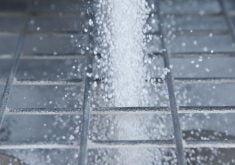Four-way knuckle system | Large land roller folds and unfolds without operator having to back up or get out of the tractor
The demand for bigger implements has caught up with rollers, some of which can exceed 100 feet yet fold to a transport width of less than 13 feet.
Like all other implements that have up-sized in recent years, the growth of field rollers was only possible with the introduction of new technology.
Rite Way land rollers have grown in size while keeping their ability to follow the contour of the land by incorporating a new four-way knuckle system to link the individual rollers together.
Read Also

Volatile temperatures expected for this winter
DTN is forecasting a lot of temperature variability in the Canadian Prairies this winter. Precipitation should be close to average.
Four-way knuckles let each individual roller section run independently, thus hugging the topography and maintaining maximum soil contact.
“This allows us to produce a seven section roller that’s 90 feet wide, but we can build them over 100 feet if we wish to do so,” says Rite Way’s Marjorie Strandlund.
The company’s latest generation of rollers has been available for about four years.
“One of the main features differentiating Rite Way land rollers from others is our patented auto fold system that lets you fold and unfold while moving forward only,” Strandlund said.
“The hydraulic steering cylinders on the transport wheels out at the tips steer the wings into the working position as you drive forward. It takes a little more than one minute to fold or unfold. You never need to back up or even get out of the tractor.”
The ability to fold and unfold without backing up makes the Rite Way roller an ideal fit behind seeding rigs, which are sometimes nearly impossible to back up.
Strandlund said another part of Rite Way’s strategy is to build large diameter rollers that are shorter. The large 42 inch diameter drum rolls over the landscape easier than small diameter drums.
A large diameter drum makes fewer revolutions and does a better job of pressing rocks into the ground compared to smaller drums in the 36 inches diameter range.
She said wide drum sections may be fine on a perfectly flat field with no rocks, but the slightest knoll or rock can lift most of the drum off the ground, resulting in large skips. Shorter drum sections maintain better soil contact.
The four way knuckle system allows each drum section to pivot side to side as well as up and down.
“Tractor requirement is three to four horsepower per foot of roller, but that’s just to pull the implement,” she said.
“When you’re pulling any implement this big and this heavy, you really need a much bigger tractor so the roller doesn’t get away from you.”
Strandlund said awareness of the benefits continue to spread as more producers invest in rollers:
- Retain moisture by sealing surface and leaving less surface exposed to the drying effect of wind.
- Enhance root system growth by squeezing air pockets out of fluffy soil, thus eliminating dead airspace.
- Press stones into the ground and level out the field for easier spraying and harvest. Research shows that a rolled level field lets the combine harvest three more bushels per acre.
- A rolled field reduces the odds of your combine swallowing a rock and also reduces the amount of gritty dust entering the combine.
- For bean growers, sealing the surface stops oxygen from accessing the iron in the soil, thus reducing the yellowing in beans.
- Rolling B.t. corn stalks and root balls in the fall helps them break down so the field is ready for the next year’s crop.
- Rolling isn’t just for corn and beans. All zero till fields are rough and hard on equipment, even cereal fields. Rolling them after seeding saves on equipment maintenance costs.
For more information, contact Rite Way at 306-337-4440 or visit www.ritewaymfg.com.
















